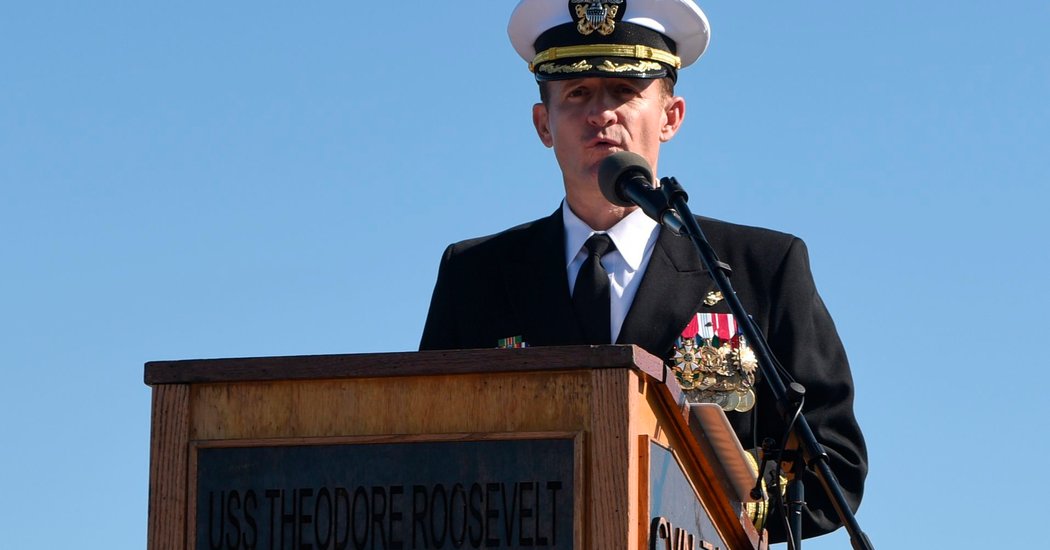[ad_1]
WASHINGTON — Capt. Brett E. Crozier should be restored to command of the aircraft carrier Theodore Roosevelt, the Navy’s top officials recommended on Friday.
But Defense Secretary Mark T. Esper, who was briefed on the recommendations, has asked for more time to consider whether to sign off on reinstating the captain of the nuclear-powered carrier.
Mr. Esper received the recommendation from the chief of Naval Operations, Admiral Michael M. Gilday, and the acting Navy secretary, James McPherson. Defense Department officials said earlier that they expected to announce the results of the Navy’s investigation into the matter on Friday afternoon.
Mr. Esper’s decision to hold up the investigation has surprised Navy officials, who believed that the defense secretary would leave the process in the hands of the military chain of command.
After he was fired by a political appointee of President Trump, the saga took on new meaning. A video of hundreds of cheering sailors yelling “Captain Crozier!” as he departed the aircraft carrier, black backpack on his shoulder, went viral. The maneuverings afterward of the acting Navy secretary at the time, Thomas B. Modly, to right a crisis in the Navy only deepened public interest.
Now, after a review of the episodes of the last month, it is Mr. Modly who is out of his job. Meanwhile, Admiral Gilday and Mr. Modly’s successor, Mr. McPherson, pushed for the reinstatement of Captain Crozier during a meeting on Friday with Mr. Esper.
Admiral Gilday and Gen. Mark A. Milley, the chairman of the Joint Chiefs of Staff, had both advised Mr. Modly not to remove Captain Crozier before an investigation into events aboard the Roosevelt was complete. But Mr. Modly feared that Mr. Trump wanted Captain Crozier fired, according to his acquaintances, and dismissed the captain.
But the president’s position softened as videos of crew members extolling their captain made their way around social media. Still, it was unclear exactly where the president now stands on the reinstatement of Captain Crozier, and Mr. Esper’s decision not to immediately accept the recommendation that the captain be reinstated could reflect a fear of getting on the wrong side of his boss, officials said.
Admiral Gilday and James McPherson, the acting Navy secretary who succeeded Mr. Modly after he resigned, reached agreement late last week that the events leading to Captain Crozier’s letter pleading for help showed that he should not have been removed, officials said. They briefed General Milley on their findings on Tuesday.
It was unclear late Friday why the defense secretary had delayed the process. His spokesman, Jonathan Hoffman, had said earlier in the day that Mr. Esper was likely to back the Navy’s conclusion. But Mr. Esper is usually closely aligned with Mr. Trump, and may want to make sure that the president will not reverse the process, as he did last year when he ordered the Navy not to punish a member of the Navy SEALs whose case had caught his attention.
Captain Crozier, who friends say is feeling better after he himself contracted the coronavirus, is in isolation in the distinguished visitors quarter on a Navy base in Guam. He is awaiting another test to confirm that he no longer has the virus, his friend said.
Representative Adam Smith, the chairman of the House Armed Services Committee, issued a statement on Friday calling for the captain to be reinstated. “While Captain Crozier’s actions at the outset of the health crisis aboard the T.R. were drastic and imperfect, it is clear he only took such steps to protect his crew,” he said. “Captain Crozier should be reinstated to his command immediately.”
Former Navy leaders echoed that sentiment. “The Navy leadership made the right call and Secretary Esper needs to support it,” said Sean O’Keefe, who was Navy secretary under President George Bush. “Captain Crozier made a decision to place his crew above himself and that’s a noble precedent.”
On April 2, when Captain Crozier walked off the gangway of the Roosevelt in Guam, where the ship is docked, some 114 Roosevelt sailors had tested positive for the coronavirus. Now, a little over three weeks later, that number stands at 840, or 17 percent of a crew of just under 5,000. On Thursday, the Navy said that it had completed testing on all 4,938 crew members. Of the total cases, 88 sailors have recovered and 4,234 have moved ashore, the Navy said. Four sailors are in the hospital with the disease.
The “core crew,” those left behind on the Roosevelt to clean and prepare the ship for those on Guam, is set to be swapped out by the end of the month. The Roosevelt is then expected to undertake sea trials, allowing the fighter-jet wing aboard to requalify for aircraft carrier landings at sea before continuing on its deployment.
But that plan has run into its own set of complications, as some of those crew members, housed in local hotels and believed to have not contracted the virus, have tested positive in recent days. A lack of space for these patients has prompted some of the crew to be moved into a warehouse on the naval base in what health care providers have deemed the “sailor shuffle.”
And on Friday, Pentagon officials said a crew member aboard the Kidd, a destroyer deployed to the Caribbean, had tested positive for the virus, marking the second time a deployed Navy ship had been stricken with the illness. In a subsequent statement, the Navy said that at least 17 other sailors had also tested positive.
John Ismay contributed reporting.


















